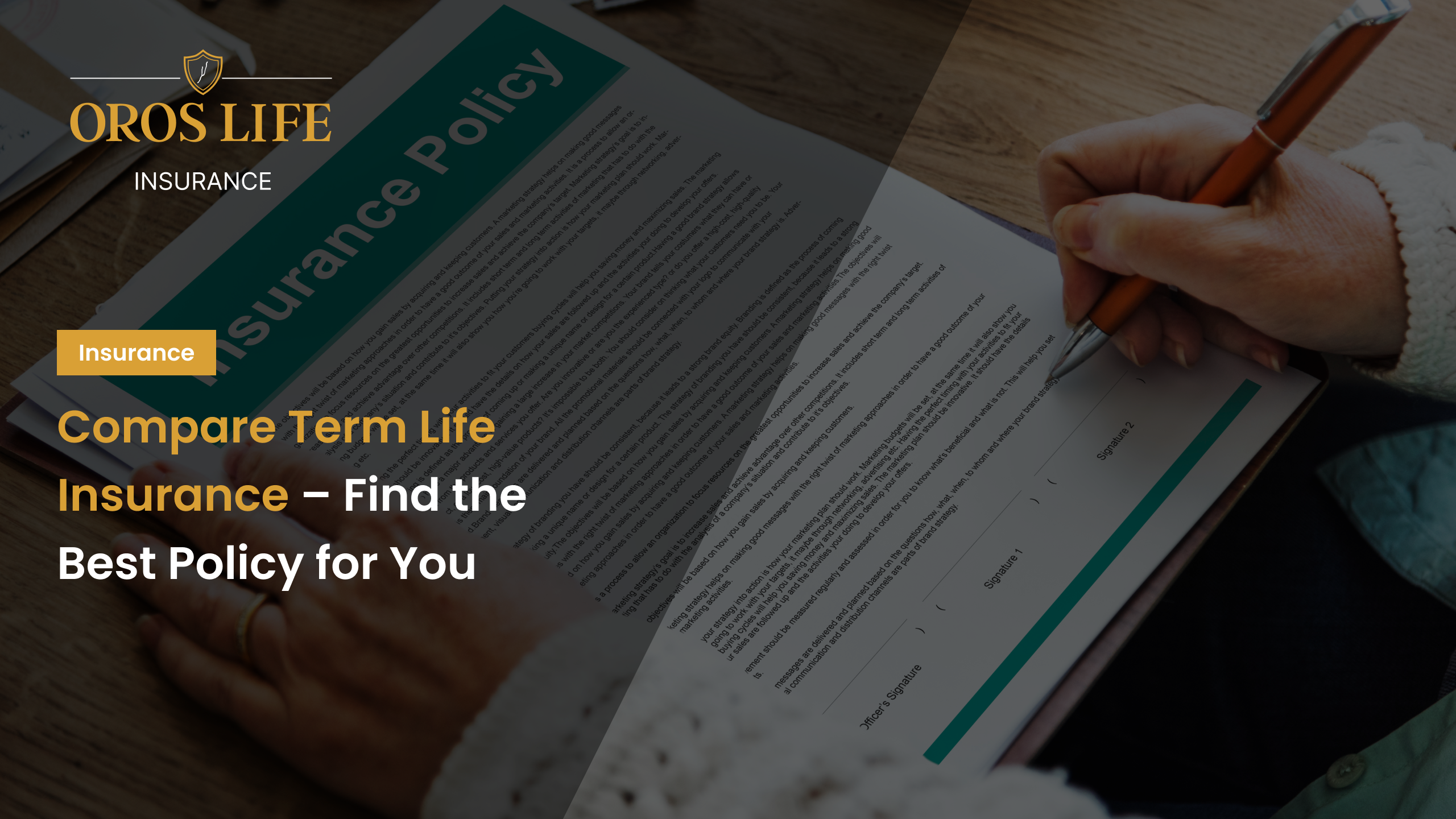With so many life insurance options available, it can be tough to decide what fits your needs. Term Life Insurance is one of the most popular options because it’s affordable and easy to understand, but choosing the right term length and coverage amount can make all the difference.
In this blog, we’ll compare different Term Life Insurance policies and help you choose the best policy that aligns with your financial goals and provides the best protection for your family.
What Is Term Life Insurance?
Term Life Insurance is a simple, affordable type of life insurance that provides coverage for a specific period of time—usually 10, 20, or 30 years. If you die during the term, your family will get a payout (death benefit). After the term ends, the policy expires, and no payout is made if you’re still alive.
Key Features of Term Life Insurance:
- Affordable premiums: Term life insurance policies typically have lower premiums than permanent life insurance options.
- Fixed coverage: You choose the coverage amount, and it stays the same for the length of the term.
- No cash value: Term life insurance policies have lower rates because they don’t generate cash value as permanent life insurance does.
- Temporary coverage: Coverage is only provided for a specified period—whether that’s 10, 20, or 30 years.
Why Choose Term Life Insurance?
1. Cost-Effective Protection
One of the main reasons Term Life Insurance is so popular is because of its affordable premiums. If you’re looking for basic coverage to protect your family while you’re alive, Term Life Insurance offers great value for your money.
For example:
- If you’re a young professional with limited financial obligations, a 10- or 20-year term might offer enough protection at a low cost.
- If you have a family or mortgage, a 30-year term could give you coverage until your kids are grown and your home is paid off.
2. Simplicity and Predictability
Unlike permanent life insurance, Term Life Insurance is straightforward and simple. You choose your:
- Coverage amount
- Term length
- Premium
The premium remains constant for the term after these choices are made. There are no complicated investment choices or fees, and you won’t have to worry about managing the policy.
Different Types of Term Life Insurance
When comparing Term Life Insurance policies, it’s important to understand that there are different types to choose from, each with its own benefits. Let’s take a closer look at some of the most common term life policies:
1. Level Term Life Insurance
With Level Term Life Insurance, both the premium and the death benefit remain fixed throughout the duration of the policy term.
Advantages:
- Predictable premiums: Your payments will never increase during the term.
- Stable coverage: The death benefit remains the same throughout the policy.
Level Term Life is great if you want consistent, long-term protection and predictable payments.
Ideal for:
- Families with long-term obligations like raising children or paying off a mortgage.
- Budget-conscious individuals who want stability and consistency in their life insurance coverage.
2. Decreasing Term Life Insurance
A sort of term insurance known as decreasing term life insurance has a death benefit that gradually drops.. This is typically designed to align with a decreasing financial obligation, such as a mortgage.
Advantages:
- Lower premiums: Since the death benefit decreases over time, the premiums are usually more affordable.
This type of policy is ideal for covering debts or loans that decrease over time, like a mortgage.
Ideal for:
- Individuals who want affordable coverage to protect a decreasing obligation, such as a mortgage or business loan.
3. Renewable Term Life Insurance
Renewable Term Life Insurance allows you to renew your policy at the end of the term without undergoing another medical exam, though the premiums will typically increase as you get older.
Advantages:
- No medical exam required: You can renew the policy even if your health has changed.
- Ongoing coverage: It gives you the flexibility to extend coverage if you still need it.
This option is great for those who might need more temporary coverage but are concerned about potential health changes down the road.
Ideal for:
- People who want to extend coverage without having to undergo another medical exam.
4. Convertible Term Life Insurance
Convertible Term Life Insurance allows you to convert your term policy to a permanent life insurance policy (e.g., Whole Life or Universal Life) without undergoing a medical exam.
Advantages:
- Option to convert: If your life situation changes, you can switch to a permanent policy without worrying about being declined due to health issues.
- Permanent protection: When you convert, you can have lifetime coverage if you need it in the future.
This option is a good fit for individuals who want the flexibility of temporary coverage now but might want permanent coverage later.
Ideal for:
- Individuals who want the flexibility to transition to permanent life insurance as their needs evolve.
How to Pick Your Ideal Term Life Insurance Plan
When comparing Term Life Insurance policies, here’s how to choose the best one for your needs:
1. Assess Your Financial Needs
Before purchasing a policy, take a moment to consider your financial obligations:
- Income replacement: How much money does your family need if you’re no longer around?
- Debt coverage: Will your family need funds to pay off a mortgage, student loans, or other debts?
- Education costs: Will you need funds for your child’s education?
Choose a coverage amount that meets these needs, ensuring your loved ones will be financially secure.
2. Choose the Right Term Length
Pick a term length based on your financial timeline:
- If you’re just starting a family, a 20-30 year term may give you enough protection while your children are growing up.
- If you only need coverage for a few years (e.g., until a business loan is paid off), a 10-year term might be sufficient.
3. Compare Premiums
Premiums can vary greatly depending on the coverage amount, term length, and your health. When evaluating insurance plans, be sure the cost is affordable while yet offering sufficient protection.
4. Consider Additional Riders
Some policies allow you to add riders for added protection, such as:
- Accidental death benefits: Additional payout if you die in an accident.
- Critical illness coverage: Payouts for serious illnesses such as cancer or heart disease.
Conclusion
Term Life Insurance is one of the most cost-effective ways to provide financial protection for your loved ones. With various policy types, flexible terms, and affordable premiums, it offers customizable coverage to fit your specific needs.
By choosing the right term length, coverage amount, and policy type, you can ensure that your family is financially protected without breaking your budget.
At Oros Life Insurance, we’re committed to helping you find the best term life insurance policy to meet your needs. Whether you’re looking for short-term protection or long-term coverage, our team is here to guide you every step of the way.
Ready to Secure Your Family’s Future?
Contact Oros Life Insurance today to explore the best Term Life Insurance options for you. We’ll help you choose the right policy for your peace of mind and your family’s security.





